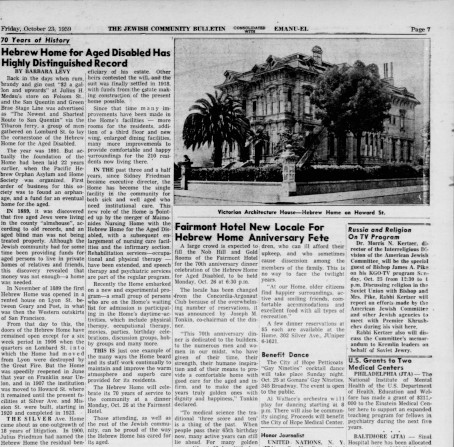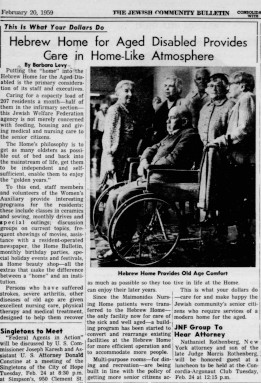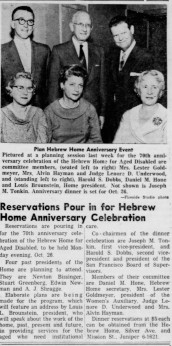What a gift to discover – 150 years of history in J. Weekly’s new digital archives. As the paper’s editor encouraged its readers, we searched for our own name in the archives. We found dozens of news stories about the San Francisco Campus for Jewish Living (SFCJL), and Jewish Home, and Hebrew Home for Aged Disabled, and Pacific Hebrew Orphan Asylum and Home Society—all names we have gone by in our organization’s 150-year history. The archives illustrate just how deeply connected our history is to that of Jewish San Francisco.
Here are some of our favorite stories:
1984
On the occasion of the dedication of our new Koret Center, an article entitled ‘How We Have Grown!’ gave a richly detailed history of our organization and its founding in 1871:
Yellowed and withering documents have been discovered authenticating the fact that the Jewish Home for the Aged was actually founded during the 1870’s. Its history was obscured for many years by the loss of invaluable records in the disastrous San Francisco Earthquake and Fire of 1906, and by a curious confusion in the overlap of two founding organizations which eventually merged as one in 1919.
As the article goes on to explain, from our origins as the Pacific Hebrew Orphan Asylum and Home Society (part of which continues to champion the cause of child welfare in San Francisco today), we would embark on a 150-year journey to serve elders in our community and innovate medical, rehabilitative, and social care for older adults.
1896
The earliest mention of the Hebrew Home for Aged Disabled was in 1896, an announcement of the organization’s annual meeting, in the eighth published issue of Emanu-El:
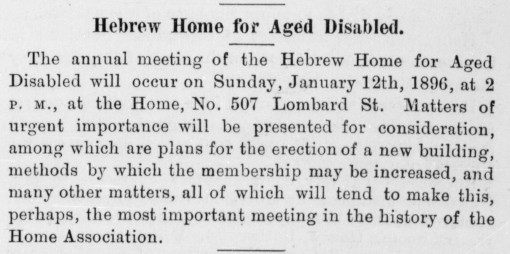
1907
A City News column from 1907 recounts Chanukah festivities:
…the first day of Chanukah was celebrated amidst merriment and rejoicing. Miss E. Martin assisted by Mrs. C. Klinger planned an excellent musical and literary program which gladdened and delighted the “aged inmates.” The “old people” were served with refreshments by the talented guests and the enjoyable afternoon concluded with appropriate remarks by President Samuel Pollack.
1920s
Numerous articles from 1920 to 1923 charted the path toward the Hebrew Home for the Aged Disabled opening its impressive new facility on Silver Avenue, including Home Superintendent Gustave Schnee’s article describing the new building with its various rooms—physicians offices, solariums, lounging rooms, kitchens, and more—and the services provided within:
Everything conducive to the comfort and welfare of the [residents] was introduced, an auditorium wherein entertainments for their pleasure can be given, a beautiful synagogue where the “eternal light” will kindle their devotional fealty and spacious grounds where they can commune with nature. The location is one that is easily accessible, so that the friends and relatives of the [residents] can readily visit them, and when the grounds surrounding the home are properly developed the institution will be second to none in the United States, and one that the Jewish community can very well be proud of.
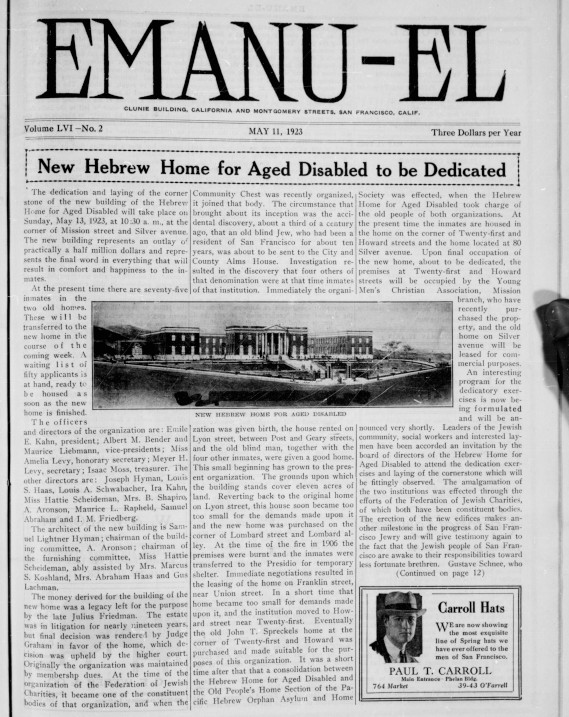
1959
In the article, ‘This Is What Your Dollars Do,’ Barbara Levy describes how donor generosity makes it possible for a “modern home for the aged” to provide care in a “home-like atmosphere:”
Putting the “home” into the Hebrew Home for the Aged Disabled is the primary consideration of its staff and executives. Caring for a capacity load of 207 residents a month —half of them in the infirmary section—this Jewish Welfare Federation agency is not merely concerned with feeding, housing and giving medical and nursing care to the senior citizens. The Home’s philosophy is to get as many oldsters as possible out of bed and back into the mainstream of life, get them to be independent and self sufficient, enable them to enjoy the “golden years.”
Our Values, Through History
Over the years, the paper would cover items as varied as accounts of Jewish Home holiday celebrations in its social column to announcements of campus expansion and the construction of new buildings, and articles about our “distinguished record” bringing “dignity to old age.”
Notable names written in the many volumes of SFCJL’s Tribute Book—a chronicle of donor generosity going back to the early 1900s—are frequently found among the notices of b’nai mitzvahs, social gatherings, business ventures, and charitable endeavors in decades of pages of the J.
The stories of SFCJL uncovered in the archives are a chronicle of how senior care has evolved over the last century, and a testament to that which is unchanged—SFCJL’s deep commitment to older adults’ dignity, wellbeing and sense of self and belonging. Our dedication to enriching the quality of life of older adults is fundamental to who we’ve always been.
Finding that self in the pages of history is a delightful reminder.
